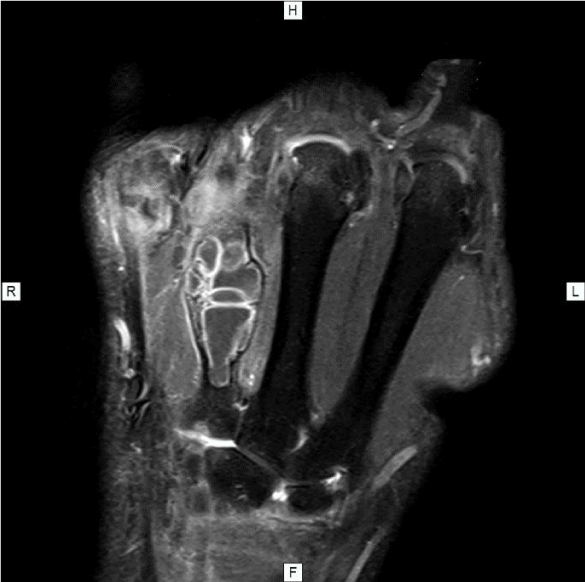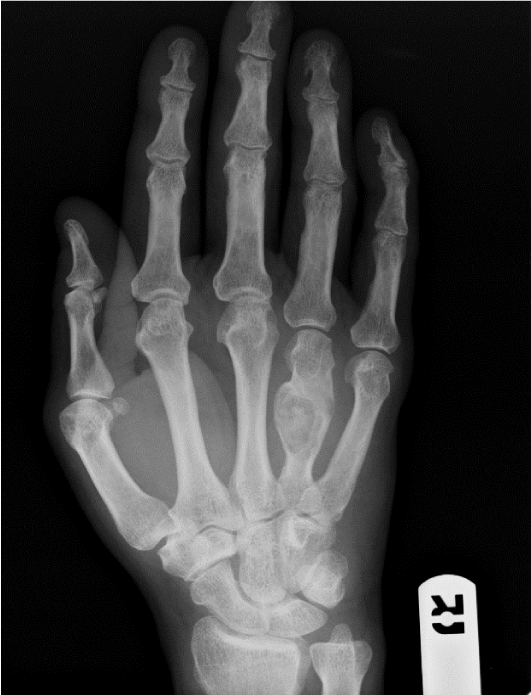Global Journal of Medical and Clinical Case Reports
Unusual Coexistence of Giant Cell Tumor and Small Bone Tuberculosis of the Hand - A Case Report
Gideon Charach*, Itamar Grosskopf, Ronen Shteinvil, Michal Ehrnwald, Hila Nochomovitz, Lior Charach, Lior Zusmanovich, Ori Rogowski and Ori Argov
Cite this as
Charach G, Grosskopf I, Shteinvil R, Ehrnwald M, Nochomovitz H, et al. (2016) Unusual Coexistence of Giant Cell Tumor and Small Bone Tuberculosis of the Hand - A Case Report. Global J Med Clin Case Reports 3(1): 026-028. DOI: 10.17352/2455-5282.000029Background: The coexistence of giant cell tumor (GCT) and metacarpal bone tuberculosis (TB) of the hand has never been described before in the English written literature. We report here a first observation.
Case presentation: We report the case of a 49-year-old male who presented with severe pain in his left hand following a blunt trauma. A plain X-ray of the metacarpal bones showed a pathological fracture of the 4th metacarpal bone (diaphysis), and computerized tomography and magnetic resonance imaging studies confirmed the diagnosis of destructive (lytic) lesions. biopsy of the metacarpal lesion revealed a GCT, and tissue cultures were positive for mycobacterium tuberculosis (TB). He was treated by a standard 4-drug protocol of isoniazid, rifampicin, pyrazinamide and ethambutol for 2 months and an additional 6 months of isoniazid and rifampicin. He then underwent excision of the metacarpal lesion, and the pathological examination showed a GCT with cultures negative for TB.
Conclusions: The correct diagnosis of this unique combination of pathologies (GCT and metacarpal bone TB) depended on a high index of clinical suspicion, referral to mycobacterial laboratory tests, careful histologic examination of tissue samples and especially radiomorphologic findings.
Introduction
Cooper first reported GCTs in the 18th century [1] and, in 1940, Jaffe and Lichtenstein refined the definition of GCTs to distinguish them from other tumors [2]. Those lesions usually occur de novo, but they may also occur as a rare complication of Paget’s disease of the bone [3-8]. GCT of bone is a rare, aggressive non-malignant lesion [1-3]. It generally occurs in adults between the ages of 20 and 40 years [3-9], and is very rarely seen in children or in adults older than 65 years of age [5-9]. GCTs occur in approximately one person in a million per year [9].
GCTs are named for their appearance under the microscope [1-3,9]. The many “giant cells” are formed by fusion of several individual cells into a single, larger complex. Normal bone also contains giant cells. GCTs of bone are characterized by a large number of giant cells in a typical background. Most bone tumors occur in the flared portion near the metaphysis, but GCTs of bone occur almost exclusively in the end portion of long bones next to the joints (epiphysis), and most frequently around the knee joint in the lower end of the thighbone (femur) or the upper end of the shinbone (tibia) [4-6]. Other common locations include the wrist (lower end of the lower arm bone), the hip (upper end of the thighbone), the shoulder (upper end of the upper arm bone), and lower back (connection of the spine and pelvis) [4-9]. A GCT may spread to the lungs in rare cases [3-9].
In contrast to GCTs, skeletal TB of the hand has become rare [10-18]. Osteoarticular TB occurs in 2.5%–5% of tubercular infections, of which 50%–60% are vertebral and which are most frequently found in the lower thoracic and lumbar regions [16]. They result from an arterial hematogenous seeding [13,14]. TB is the second-most common cause of death from infectious disease (after HIV/AIDS) [15]. When it spreads to the bones, it is also known as “osseous tuberculosis”, a form of osteomyelitis [15,16]. We report here a first observation of the coexistence of GCT and metacarpal bone TB of the hand which has never been reported.
Case Presentation
An Ukraine-born 49-year-old male presented to the emergency room with severe pain in his left hand, deformation and swelling of the 3,4,5 metacarpal area, following a blunt trauma. A plain X-ray for suspected fracture of the metacarpal bones showed a pathological fracture of the 4th metacarpal bone (diaphysis) (Figures 1,2). Computerized tomography (CT) and magnetic resonance imaging studies confirmed the diagnosis of destructive (lytic) lesions. A bone scan for determining possible spread of the tumor showed a “hot spot” in the metacarpal bone where the tumor was located. An open biopsy of the metacarpal lesion revealed a GCT, and tissue cultures were positive for mycobacterium tuberculosis (TB).
Extensive investigation for the port of entry for mycobacterium included purified protein derivative which was 10 mm. Sputum, urine and gastric lavage cultures were negative. A CT of the chest and abdomen and pelvis were negative both for tumor spread and TB lesions.
The patient was asymptomatic except for the pain in his left hand. He was treated for TB by a standard 4-drug protocol of isoniazid, rifampicin, pyrazinamide and ethambutol for 2 months and an additional 6 months of isoniazid and rifampicin. After a full course of therapy for TB, the patient underwent excision (curettage) of the metacarpal lesion, and the pathological examination showed a GCT with cultures negative for TB.
Discussion
The coexistence of GCT and metacarpal bone tuberculosis TB of the hand has never been described before. The clinical and radiographic differential diagnosis of a GCT usually includes a variety of polyostotic skeletal lesions, such as Brown’s tumor, Paget’s disease, osteomyelitis, non-ossifying fibroma, enchondromatosis, fibrous dysplasia, giant cell reparative granuloma, Langerhans cell histiocytosis, vascular tumor, osteosarcoma, hematopoietic malignant tumor, and metastasis and TB [7-10]. It is more commonly found in developing countries and especially in India, where osteoarticular TB is considered in the differential diagnosis of lytic bony lesions [10]. A definitive diagnosis usually requires biopsy with histopathologic confirmation [11-17].
The appearance of a GCT in metadiaphyseal regions is uncommon [10,18]. One reported patient had a lesion located in her second metatarsus, which, although not purely diaphyseal but rather metadiaphyseal, was very close to the epiphysis [18]. With two exceptions, all the cases reported by Uppin S. occurred in the expected location for a GCT, i.e., the epiphysis or metaepiphysis [17] Only one patient had a lesion in the diaphysis of her second metacarpus [17], a location that is considered as being very unusual for a GCT [10,18,19].
GCTs of the bones of the hands or feet are uncommon. It is important to distinguish that subset of GCTs from other giant cell-rich lesions that are more common in those sites, including aneurysmal bone cyst, osteosarcoma, and non-ossifying fibroma [19]. In one series of Indian patients with GCTs, 46.0% were caused by infections, the majority of which were TB [17]. Biscaglia et al., reported that 5.3% of tuberculous osteomyelitis involves hands and feet, and that awareness and correlation of clinical, radiologic, and pathologic findings are essential for accurate diagnoses [18].
We consider that mycobacterium TB had been embedded in the bone for many years following a primary complex infection, but we have no explanation for why the GCT appeared at precisely the same site as the TB. Another unique feature of this case is that the GCT appeared in the diaphysis: the classic location is in the flared portion near the ends of long bone (metaphysis) and epiphysis.
Conclusions
The combined appiaence of GCT and TB is extremely rare.
It is important to distinguish GCTs of the hand from other giant cell-rich lesions more common in those sites, including TB (7-10, 17-19). The correct diagnosis depends on a high index of clinical suspicion, referral to mycobacterial laboratory tests, careful histologic examination of tissue samples and especially radiomorphologic findings.
We acknowledge Esther Eshkol for editorial assistance.
Consent for publication
Written informed consent was obtained from the patient for publication of this case report and accompanying images. A copy of the written consent is available for review by the Editor-in-Chief of this journal.
Availability of data and materials
Data and materials are available on request from the corresponding author.
Authors’ contributions
All authors contributed to the treatment of the patient and in writing and final approval of the manuscript.
- Cooper AS, Travers B (1818) Surgical essays. London, England: Cox Longman & Co. 178-19 1 .
- McDonald SG (1998) Surgery for bone and soft tissue sarcomas. New York: Lippincott Williams & Wilkins. 756.
- Campanacci M, Baldini N, Boriani S, Sudanese A (1987) Giant-cell tumor of bone. J Bone Joint Surg Am 69: 106-114 .
- Wilkerson JA, Cracchiolo A 3rd (1969) Giant-cell tumor of the tibial diaphysis. J Bone Joint Surg Am 51: 1205-1209 .
- Errani C, Ruggieri P, Asenzio MA, Toscano A, Colangeli S, et al. (2010) Giant cell tumor of the extremity: a review of 349 cases from a single institution. Cancer Treat Rev 36: 1-7 .
- Karpik M (2010) Giant cell tumor (tumor gigantocellularis, osteoclastoma) - epidemiology, diagnosis, treatment. Ortop Traumatol Rehabil 12: 207-215 .
- Hoch B, Inwards C, Sundaram M, Rosenberg AE (2006) Multicentric giant cell tumor of bone. Clinicopathologic analysis of thirty cases. J Bone Joint Surg Am 88: 1998-2008 .
- Oliveira VC, van der Heijden L, van der Geest IC, Campanacci DA, Gibbons CL, et al. (2013) Giant cell tumours of the small bones of the hands and feet: long-term results of 30 patients and a systematic literature review. Bone Joint J 95-B: 838-845.
- Quinn R (2010) Giant cell tumor of bone. Ortho Info, AAOS .
- Bajpai J, Meel O, Khatkar V, Saini S, Bajpai A (2014) Multi-centric giant cell tumor involving the distal fibula and talus misdiagnosed as tuberculosis: a case report. Foot Ankle Online J 7: 2 .
- Farshchi S, Hasibi M, Ashtiani MT, Yazdani N, Mokhtari Z, (2013) A misdiagnosis led to an extensive skull base surgery: infratemporal tuberculosis mimicking giant cell tumor. Indian J Otolaryngol Head Neck Surg 65: 83-85 .
- Pan KL, Ibrahim S (2000) Tuberculosis of the distal end of the radius mimicking a giant-cell tumor. Med J Malaysia 55: 105-106 .
- Rieger H, Pennig D, Edel G, Brug E (1990) Tuberculosis of the hand. Handchir Mikrochir Plast Chir 22: 183-190 .
- Sellier P, Wyler A (2007) Disseminated tubercular osteitis. CMAJ 177: 148 .
- Dolin, [edited by] Gerald L. Mandell, John E. Bennett, Raphael (2010) Mandell, Douglas, and Bennett's principles and practice of infectious diseases (7th ed.). Philadelphia, PA: Churchill Livingstone/Elsevier. 250 .
- Kumar V, Abbas AK, Fausto N, Mitchell RN (2007) Robbins basic pathology (8th ed.). Saunders Elsevier 516-522 .
- Uppin SG, Sundaram C, Umamahesh M, Chandrashekar P, Rani YJ, et al. (2008) Lesions of the bones of the hands and feet: a study of 50 cases. Arch Pathol Lab Med 132: 800-812 .
- Biscaglia R, Bacchini P, Bertoni F (2000) Giant cell tumor of the bones of the hand and foot. Cancer 88: 2022-2032 .
- Fain JS, Unni KK, Beabout JW, Rock MG (1993) Nonepiphyseal giant cell tumor of the long bones: clinical, radiographic and pathologic study. Cancer 71: 3514 -3519 .

Article Alerts
Subscribe to our articles alerts and stay tuned.
 This work is licensed under a Creative Commons Attribution 4.0 International License.
This work is licensed under a Creative Commons Attribution 4.0 International License.


 Save to Mendeley
Save to Mendeley
